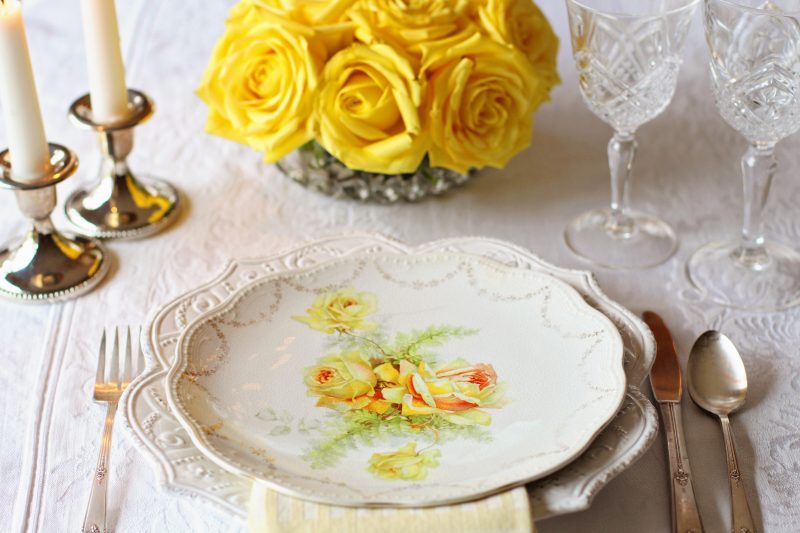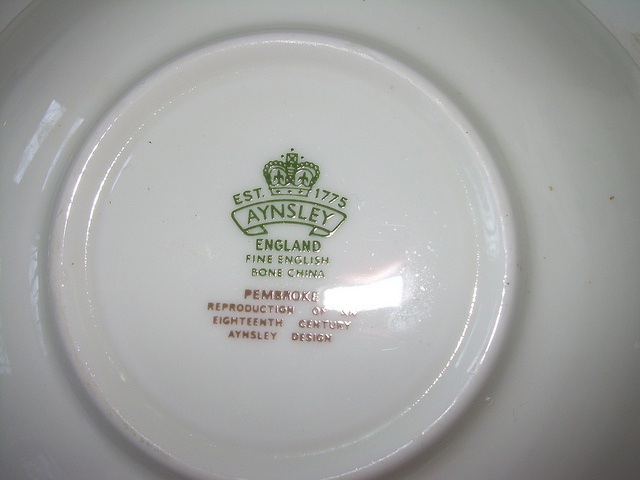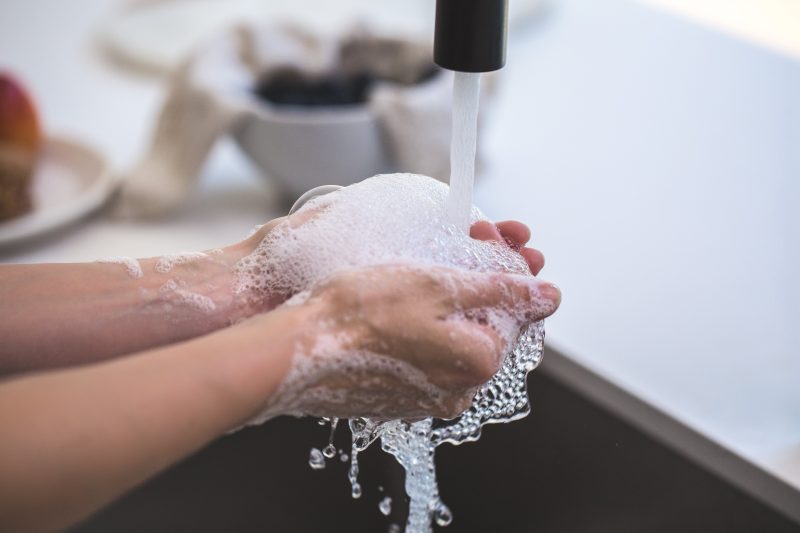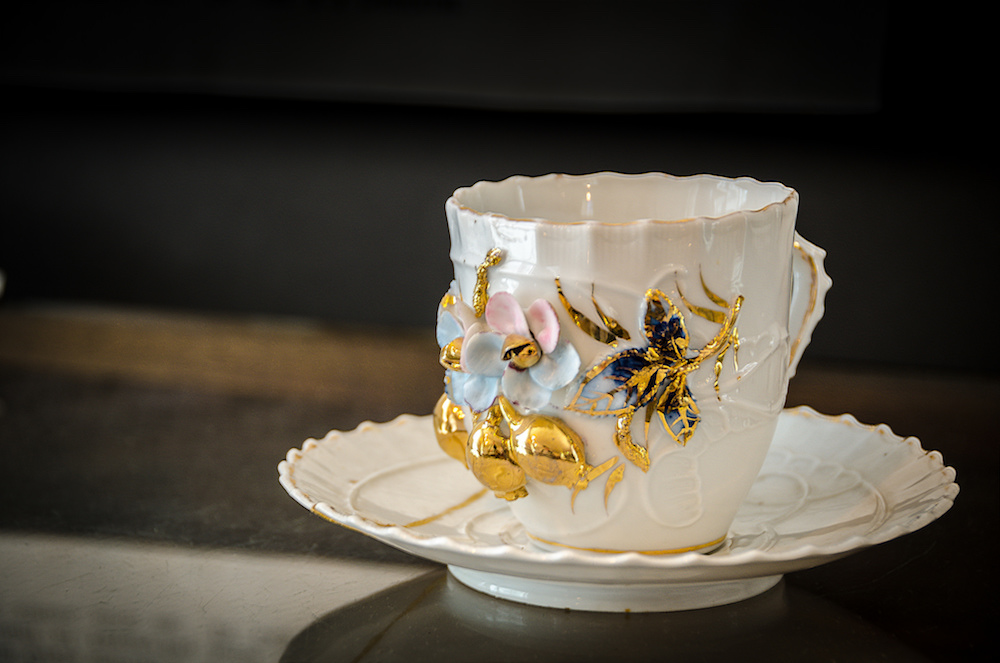Header image CC image courtesy of Barta IV on Flickr
What is Bone China?
Bone china is exactly as it sounds – china dishes made with fine bone ash. The ash from cow bones adds strength by making the dishes softer. This allows the dishes to be thinner and smoother than traditional porcelain and reduces chipping. The bone ash also gives the china a beautiful creamy white color and translucency.
The dishes are a luxury item and highly priced because they require expensive materials and a labor intensive process. Today’s bone china formula is very similar to the original formula in the late 1700s. This recipe of china was almost exclusive to English porcelain manufacturers up until the late part of the 20th century.
What is Bone China made of?
In order to be considered fine bone china, the formula must contain at least 30% bone ash. Cow bones are used for the ash because they contain a low iron content. The bones are crushed and then fired at very high temperatures to produce the ash, which is then milled to a very fine particle size.
Bone china also contains clay, kaolin, quartz, and feldspar.
Bone china is much softer than porcelain and undergoes two firing processes. The first is around 2,200 degrees fahrenheit and causes the product to shrink. Interestingly, a significant number of pieces break in this first firing, which also necessitates the high price tag. Bone china is still porous after the first firing, so the product must next be glazed.
Traditional porcelain pieces without bone ash are thicker and chunkier than bone china. They are also very strong, but the delicate appearance and elegance of luxury bone china cannot be achieved.
Bone China vs Fine China vs Porcelain
Is there a difference between bone china and fine china? Where does porcelain fall in to the mix? First of all, yes – bone china and fine china are different. Fine china does not include bone ash in the formulation. However, this does not mean that bone china is stronger than fine china or that all of your fine china will chip.

Fine china will not have the creamy color of bone china – it is usually a much brighter white. Fine china is also not likely be as thin and delicate looking as bone china. Both can be very elegant, expensive, and useful for formal dinnerware or tea service.
Fine china also has the same ingredients as porcelain, but is fired at a lower temperature, which makes it softer than porcelain.
The firing process is a large part in what determines whether the final product is porcelain or fine china. Porcelain is very strong and can be used in many applications, from bath tubs to electrical insulators. A single high temperature firing at 2,600 degrees Fahrenheit creates porcelain.
Bone China Decorations and Patterns
Traditionally, bone china was hand painted. Today, there are other options for applying decorations to the pieces such as spraying, applying decals, and gold finishing.
Some decals are applied by machine, and others by hand. Most fine bone china also has metallic around the edges of the plates, bowls, and cups. This is called gilding and is usually done by hand.
Since bone china has been around for so long and is quite expensive, many pieces are passed down as heirlooms.
Many china patterns have been in continuous production since their popularity soared in 1800. Floral patterns, asian motifs, nature-inspired styling, figural scenes are common.
How to know if you have Bone China
Do you think your great grandma’s dishes are bone china? There’s a few easy ways to tell. First, you could look up the manufacturer, pattern, and number located on the bottom of the pieces. This is called the backstamp and is usually easy to identify.
If the writing is worn off or it doesn’t have a stamp (some early pieces don’t), hold a plate up to the light and place your fingers behind it. You should be able to see light and shadows from your hand behind the plate.

Bone china also has a distinct ring to it. Lightly tap the piece with a coin and if it has a high pitched tone, it’s likely bone china.
A complete set can be extremely valuable depending on the age, design, and manufacturer.
How to Care for Bone China
In recent years, companies have taken efforts to increase the versatility and durability of bone china. Lennox has even created some versions with gold gilding that are safe to use in the microwave. Always read the care instructions for your new china. It is an expensive investment and well-cared for china can be passed down for generations.
Older china was made be hand washed. A mild soap dishwashing soap like Ivory or Dawn is recommended along with a non abrasive sponge or washcloth. Rinse off food immediately and never let the dishes sit overnight. Acidic foods like tomato sauce can leave stains, so it’s important that you care for the dirty dishes right away.
For stubborn stains, use a baking soda and water paste and gently scrub the stain. A solution of 50/50 table salt and vinegar can also work. Soak for a few minutes before trying again. Extreme stains may warrant a hot water rinse, a dab of cream peroxide (found at beauty stores), and basting in a plastic bag for a day.
Stacking dishes in the sink can lead to cracks, so it’s best to line them up on the counter or take them from the table to wash one-by-one. If there are some stains, let the dish soak in soapy water.
Let the dishes air dry in a plastic rack, since metal can scratch off patterns or chip the dishes. You could also dry them with a soft rag.

Never load your fine bone china in the dishwasher since dishwashing detergents are quite harsh and the water too hot. Dishes can also rub against each other or on the rack, causing scratches or cracks.
When storing your china, stack the plates or bowls with a thick napkin or linen rag between each of them to prevent scratching and chipping. Never stack more than four high to avoid weakening the rims. Avoid hanging cups and mugs by their handles, which can also weaken them.
Lastly, avoid extreme temperature changes. For example, do not pour very hot tea directly in to the cup. Set a spoon in the bottom first or a bit of milk to distribute the heat.
